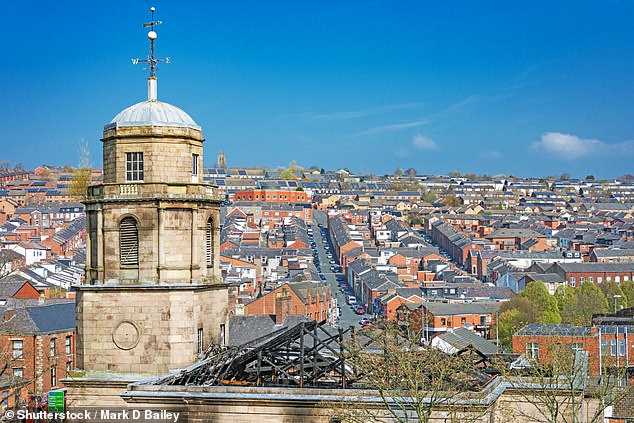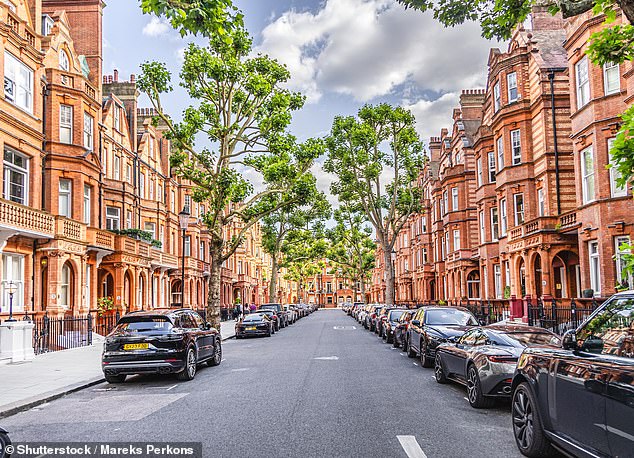The average home rose in value by 4.9 per cent in the 12 months to January and is now fetching £269,000, according to the most recent official figures.
But some local areas are seeing double-digit price increases, while others are seeing double-digit falls.
Estate agent Hamptons has crunched the latest Office for National Statistics data and revealed that one area in Lancashire has seen prices rise 12 per cent year-on-year.
Conversely, two areas in London have seen values fall more than 17 per cent in that time.
The data also shows a north-south divide. Nine out of the 10 local authorities with the biggest house price growth are in the midlands, north of England or Scotland, with only one area in the south of England featuring on the list.
Meanwhile, six of the 10 local authorities that have recorded the largest house price falls are located within London.

Top of the table: In this Lancashire borough, the average home has risen in value by 12% – going from £139,910 at the start of 2024 to £156,750 at the start of this year
Places where house prices have risen
The local authority that has seen the biggest house price gains over the past year is Blackburn with Darwen in Lancashire.
The average home there has risen by 12 per cent from £139,910 at the start of 2024 to £156,750 at the start of this year.
The borough can be found just north of Manchester and east of Preston.
Susan Wolstenholme, branch manager at Bridgfords estate agents in Blackburn said she has seen prices boom over the past year as soaring rents pushed people to get on the housing ladder.
‘Rental prices have gone up and that has forced a lot of people who were renting to try their best to get hold of whatever money they can from family to buy instead.
‘It use to be £450 to £650 a month round here for rent. Now we are looking at £650 to £1,200, so people are just trying to jump on the ladder.
She says buyers are also willing to move to a less desirable area if it means getting on the ladder.
‘We are seeing more people buy in the cheaper areas that were previously unpopular with people trying to escape the unaffordable rental market,’ Wolstenholme adds.
‘There is a lack of stock at the lower price range and a lot of people are ready to jump on anything that comes up for sale.
‘We are finding we are inundated with people looking to buy. For example, we have one house with an asking price of £75,000 and within the week we have got £81,000 and there are 40 viewings booked in.’
As for Blackburn and the surrounding area, Wolstenholme says it has plenty going for it.
‘The area is well connected. You have motorways and beautiful countryside at every turn. And of course you have low house prices.’
Another area to see house prices surge this year is Harborough in the East Midlands.
The local authority, which includes the towns of Market Harborough and Lutterworth, has seen average prices rise 10.8 per cent since last year.
South Staffordshire, which is situated north west of Birmingham and Wolverhampton has recorded 10.4 per cent annual house price growth.
Places where house prices have fallen
The City of Westminster in London, which includes areas such as Westminster, Mayfair and Maida Vale has seen prices tumble 17.2 per cent over the past year according to ONS figures.
Kensington and Chelsea has also seen prices fall by a staggering 17.1 per cent, according to the data.
Neighbouring Hammersmith and Fulham has seen prices fall by 9.2 per cent year-on-year.
James Stuart-Mogg, head of sales at John D Wood & Co. in Kensington puts the faltering central London market down to a number of factors.
One is the stamp duty surcharge imposed on second home buyers, which make up a large proportion of buyers in these areas.
Since changes were made in the Autumn Budget, someone buying a £1million second property now pays £93,750 in property tax.
Someone buying a £2million property pays £253,750, and someone buying a £5million second property pays £763,750.
The cost is even more for overseas buyers who pay an additional 2 per cent surcharge on top.
‘The sharp rise in stamp duty, which is now up to 17 per cent for second homeowners – has had a significant impact,’ said Stuart-Mogg.
‘That said, the area remains one of London’s most desirable, offering an exceptional variety of homes, world-class shopping, cultural institutions, and excellent transport links.
‘While European buyers are still present, we’ve seen increasing activity from Middle Eastern, Asian, and particularly American buyers taking advantage of a strong dollar.’
Stuart Bailey, head of London super prime sales at Knight Frank takes a similar view on the market.
‘There’s no doubt that some self-made entrepreneurs – the profile of most super prime buyers – are leaving London’s golden postcodes, feeling undervalued and unwanted,’ said Bailey.
‘And stamp duty is clearly super high, with an especially big impact in a low or negative growth market. This slows the opportunity for first time buyers, as supply higher up the ladder stalls, due the unattractive sideways cost of SDLT.
‘There is undoubtedly downward pressure on pricing, though uncertainty and chaos elsewhere in the world safeguards London’s safe haven status. But we should not be complacent about this, as it is more by default than design.’
Some local agents even question whether the data paints a fair picture of what’s really happening.
This is predominantly because sales volumes are fairly low in these areas, and the value of homes varies significantly, which can distort a monthly average price and cause volatility.
For example, flat sales can vary in these areas from £500,000 up to £50million.

Kensington and Chelsea has seen prices fall by a staggering 17.1 % according to the data
Christian Lock-Necrews, of Winkworth’s Knightsbridge, Belgravia and Chelsea office said: ‘The average price of properties sold in January 2025 versus January 2024 does not provide huge insight into market dynamics given it is being considered in isolation, whereas trends in movement are of more relevance.
‘It clearly tells us that more low value properties have sold, rather than higher value properties.
‘Separately the volume of transactions at the upper end of the market is always small due to the nature of the value of those properties, therefore a handful of sales can have a disproportionate impact on average prices; so that could also have an effect.’
Some links in this article may be affiliate links. If you click on them we may earn a small commission. That helps us fund This Is Money, and keep it free to use. We do not write articles to promote products. We do not allow any commercial relationship to affect our editorial independence.






